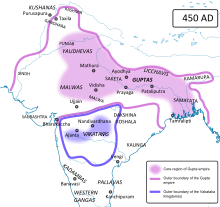Pushyamitras Invasion
| Pushyamitras Invasion | |||||||||
|---|---|---|---|---|---|---|---|---|---|
| Part of Wars of Gupta Empire | |||||||||
| |||||||||
| Belligerents | |||||||||
|
|
Panduvamshis | ||||||||
| Commanders and leaders | |||||||||
|
|
Bharatabala | ||||||||
Kumaragupta I had attacked Vakataka Dynasty in his Deccan Campaign in alliance with the Nala Dynasty. Narendrasena soon recaptured his capital and causes disturbance in the Gupta territory capturing Malwa Kosala, Mekala from Gupta Emperor Kumaragupta I.
This Vakataka–Kadamba alliance is mentioned as "Pushyamitras" or "Yudhyamitras" by SkandaguptaThey were defeated by Skandagupta with great difficulties their Invasion caused great trouble for the Guptas.

Background
[change | change source]After the death of Pravarasena II, there may have been a struggle over who would take the throne. Narendrasena eventually became the ruler, but Vakataka records suggest that he had to "restore the fortunes of his family" after a difficult time. Historians believe this could mean he dealt with problems caused by the succession conflict.[1] However, historian A.S. Altekar has a different idea. He thinks the records describe an invasion by Bhavadattavarman, a king of the Nala dynasty from Bastar, and Kumaragupta of the Gupta Empire. These rulers likely attacked Vidarbha and took Nandivardhana, the old Vakataka capital. Altekar believes Narendrasena managed to defeat both the Nalas and the Guptas and reclaim his kingdom.[1]
Invasion of Pushyamitras
[change | change source]Kumaragupta and Pushyamitras
[change | change source]Historian Altekar believes that Narendrasena, a Vakataka ruler, successfully defeated the Nalas and took control of their kingdom after the death of Bhavadattavarman. Inscriptions from Narendrasena's son, Prithivishena II, state that rulers of Kosala, Mekala, and Malava recognized Narendrasena's power. This suggests that Narendrasena significantly expanded the Vakataka kingdom. During this time, the Gupta Empire, which was a major power in northern India, was busy fighting the invading Hunas. This likely gave Narendrasena the opportunity to strengthen and expand his rule in central India. Kumaragupta I of Gupta Empire seems to have face reverses from the hands of the alliance termed as "Pushyamitras".
According to one theory, the later years of Kumaragupta's reign were not peaceful. This theory is based on the c. 448 CE Mankuwar Buddha inscription issued during Kumaragupta's reign, and the Bhitari pillar inscription of Skandagupta:[2][3]
- The Bhitari inscription states that Skandagupta defeated his enemies and re-established the "ruined fortunes" of his family when his father died, and then visited his mother whose "eyes were full of tears of joy".[2] The enemies mentioned in the inscriptions include the Pushyamitras or the Hunas; an alternative interpretation reads "yudhyamitras" (a generic term for enemies) instead of Pushyamitras.[2]
- The Mankuwar Buddha inscribed with "year 129 in the reign of Great King Kumaragupta" (448 CE, at the end of the reign of Kumaragupta) only uses the feudatory title Maharaja (



 , "Great King") for Kumaragupta instead of the imperial title Maharajadhiraja ("Great King of Kings"). This has led to suggestions that he suffered reverses in the later part of his reign, possibly against the Pushyamitras or the Hunas.[3]
, "Great King") for Kumaragupta instead of the imperial title Maharajadhiraja ("Great King of Kings"). This has led to suggestions that he suffered reverses in the later part of his reign, possibly against the Pushyamitras or the Hunas.[3]
Skandagupta and Pushyamitras
[change | change source]The events between 455 and 467 CE highlight Skandagupta's role in defeating the Pushyamitras.[4]
By whom, when [Skandagupta] prepared himself to restore the fallen fortunes of (his) family, a (whole) night was spent on a couch that was the bare earth; and then, having conquered the Pushyamitras, who had developed great power and wealth, he placed (his) left foot on a footstool which was the king (of that tribe himself).
— Line 10, Bhitari pillar inscription of Skandagupta[5]
Skandagupta, the son of Kumaragupta, faced a long and tough battle against the Pushyamitras, who had grown strong and wealthy with significant military resources.[6][7] According to inscriptions, the situation became so critical that Skandagupta once had to spend an entire night sleeping on the ground during the campaign. Despite the difficulties, he managed to overcome the crisis and achieve victory.
This victory likely occurred towards the end of Kumaragupta's reign, when Kumaragupta was too old to lead the army.[6][7] As a result, Skandagupta was chosen to handle the threat. His victory was so important that, as mentioned in the Bhitari inscription, songs praising his bravery and achievements were sung across the empire. Historian Goyal believes that the Pushyamitra rebellion was led by the Panduvamshi king Bharatabala.[6]
References
[change | change source]- ↑ 1.0 1.1 History Of The Imperial Guptas.
- ↑ 2.0 2.1 2.2 A Comprehensive History of India: pt. 1. A.D. 300-985. People's Publishing House. 1981. p. 69.
- ↑ 3.0 3.1 Sharma, Tej Ram (1989). A Political History of the Imperial Guptas: From Gupta to Skandagupta. Concept Publishing Company. p. 117. ISBN 978-81-7022-251-4.
- ↑ "A History of India". www.google.com. Retrieved 2024-12-18.
- ↑ Tripathi, Ram Prasad (1981). Studies in political and socio-economic history of early India. Neeraj Prakashan. p. 37.
- ↑ 6.0 6.1 6.2 Sinha, Bindeshwari Prasad (1977). Dynastic History of Magadha. p. 22.
- ↑ 7.0 7.1 Agrawal, Ashvini (1989). Rise and Fall of the Imperial Guptas. Motilal Banarsidass Publ. p. 189. ISBN 978-81-208-0592-7.
